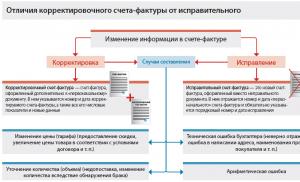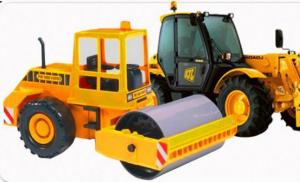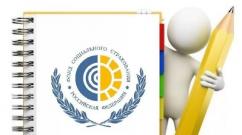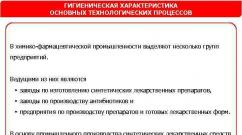"atmospheric pressure". Design and research work in physics “Experiments with atmospheric pressure Experiments proving that atmospheric pressure is high
Purpose of the work: to prove the existence of atmospheric pressure. Purpose of the work: to prove the existence of atmospheric pressure. Equipment and materials: Equipment and materials: glass filled with water glass filled with water paper. paper. Doing the job Doing the job
Fill an ordinary glass to the brim with water. Cover it with a piece of paper as shown in the figure. Covering it tightly with your hand, turn it over with the paper facing down. Carefully remove your hand, holding the glass by the bottom. Water does not pour out. Fill an ordinary glass to the brim with water. Cover it with a piece of paper as shown in the figure. Covering it tightly with your hand, turn it over with the paper facing down. Carefully remove your hand, holding the glass by the bottom. Water does not pour out. This happens because the water is held in place by air pressure. Air pressure spreads equally in all directions (according to Pascal's law), which means it also applies upward. The paper serves only to ensure that the surface of the water remains completely flat. This happens because the water is held in place by air pressure. Air pressure spreads equally in all directions (according to Pascal's law), which means it also applies upward. The paper serves only to ensure that the surface of the water remains completely flat.
Experience with glasses. Let's take two glasses, a candle stub, some newsprint, and scissors. Place the lit candle stub in one of the glasses. From several layers of newsprint, placed one on top of the other, cut out a circle with a diameter slightly larger than the outer edge of the glass. Then we cut out the middle of the circle so that most of the hole in the glass remains open. By moistening the paper with water, we will obtain an elastic pad, which we will place on the upper edge of the first glass. Carefully place the inverted second glass on this gasket and press it against the paper so that the internal space of both glasses is isolated from external air. The candle will soon go out. Now, holding the top glass with your hand, lift it. We will see that the lower glass seems to have stuck to the upper one and rose with it.

This happened because the fire heated the air contained in the lower glass, and, as we already know, heated air expands and becomes lighter, so some of it came out of the glass. When we slowly brought the second glass closer to the first glass, part of the air contained in it also managed to heat up and came out. This means that when both glasses were pressed tightly against each other, there was less air in them than before the experiment began. The candle went out as soon as all the oxygen contained in the glasses was consumed. After the gases remaining inside the glass cooled down, a rarefied space appeared there, and the air pressure outside remained unchanged, so it pressed the glasses tightly against one another, and when we lifted the upper one, the lower one rose along with it. The glasses would be pressed even more tightly together if we managed to create a completely empty space inside them.


Conclusion: so we have proven the existence of atmospheric pressure with the two experiments given above. Conclusion: so we have proven the existence of atmospheric pressure with the two experiments given above. The work was completed by Elena Vasilyeva and Kristina Vasilyeva The work was completed by Elena Vasilyeva and Kristina Vasilyeva
WHAT AIR CAN DO
Experience 1
He can, for example, flip a coin! Place a small coin on the table and throw it into your hand with a push of air. To do this, holding your hand behind the coin, blow sharply onto the table. Just not in the place where the coin lies, but at a distance of 4-5 cm in front of it.

The air compressed by your breath will penetrate under the coin and throw it straight into your handful.
A few trials - and you will learn to take a coin from the table without touching it with your hand!
Experience 2
If you have a narrow conical glass, you can do another fun experiment with coins. Place a penny at the bottom of the glass and a nickel on top. It will lie horizontally, like a lid, although it does not reach the edge of the glass.
Now blow sharply on the edge of the penny.

It will stand on its edge, and the penny will be thrown out with compressed air. After this, the nickel will fall into place. So the invisible man helped you get a penny from the bottom of the glass without touching it or the penny lying on top.
Experience 3
A similar experiment can be done with egg cups. Place two of these glasses side by side and put an egg in the one closest to you.
In case of failure, take a hard-boiled egg. Now blow strongly and sharply into the place indicated by the arrow in the picture, right at the very edge of the glass.

The egg will jump up and “transplant” into the empty glass!
The invisible air slipped between the edge of the glass and the egg, burst into the glass, and so hard that the egg jumped up!
For some, this experience does not work out - “they lack the spirit.” But if instead of a hard-boiled egg you take an empty, blown-out shell, you will surely succeed!
HEAVY AIR
Take a wide wooden ruler (which you don't mind). Balance it on the edge of the table so that with the slightest pressure on the free end the ruler will fall. Now spread a newspaper on the table on top of the ruler. Gently spread it out, smooth it out with your hands, straighten out all the wrinkles.
Previously, the ruler could be tipped over with your finger. Now a newspaper has been added, but how much does it weigh? Come on, be bold: stand on the side of the ruler and hit its end with your fist!
Even my fist hurt, and the ruler lay there as if it was nailed down. Well, now we'll show her how to resist! Take a stick and hit with all your might. Bang! The ruler is in half, and the newspaper lies as if nothing had happened.

Why was the newspaper so heavy?
Yes, because air is pressing on it from above. 1 kg per square centimeter. And the newspaper has so many square centimeters! Well, calculate how much area this is? Approximately 60 x 42 = 2520 cm2. This means that the air presses on her with a force of two and a half thousand kilograms, two and a half tons!
Lift the newspaper slowly - the air will penetrate under it and press down from below with the same force. But try to tear her off the table at once, and you’ve already seen what happens. The air does not have time to get under the newspaper - and the ruler breaks in half!
SCHOOL RUBBER SUCKER
Of the three objects named in the title, the octopus is the least convenient for experiments. Firstly, it is difficult to get, and secondly, an octopus is not to be trifled with. How it grabs you with its terrible tentacles, how it sucks you in with its suction cups - you won’t be able to tear it off!
Zoologists say that the octopus's sucker is shaped like a cup with a circular muscle. The octopus tenses its muscles; the cup shrinks and becomes narrower. And then, when this cup presses against the prey, the muscle relaxes.
Look how interesting it is: in order to hold its prey, the octopus does not tense its muscles, but relaxes them! And still the suckers stick. Like a radish on a plate!
Experience
You and I had to abandon experiments with a living octopus. But we will still make one suction cup - an artificial suction cup, from a school gum.

Take a soft rubber band and make a hole in the middle of one side. This will be the suction cup. Well, let’s use your muscles. After all, they are only needed to squeeze the suction cup at first, and then they still relax, so that the hand can be removed.
Squeeze the rubber band to make the cup smaller and press it onto the plate. Just wet it first: the gum is not a radish, it doesn’t have its own juice. By the way, the octopus also “works” with wet suction cups.
Did you press the rubber band?
Now let go, she has attached herself securely.
There are also soap dishes with rubber suction cups. They stick to the tiled bathroom wall. They also need to be wetted first, and then pressed against the wall and released. Hold on!
Well, now about the fly!
Tell me, have you ever wondered how she walks on the wall and even on the ceiling?

There is even a riddle: “What’s upside down above us?” Maybe the fly has claws at the ends of its legs? The hooks with which it clings to uneven walls and ceilings? But she walks completely freely on the window glass and on the mirror. There's nothing there for a fly to grab onto. It turns out that flies also have suction cups on their legs.
So, after this, assert that there is nothing in common between a fly and an octopus.
HOW TO EMPTY THE GLASS?
The glass and bottle are filled with water. You need to empty the glass with the bottle without emptying it.
Make two holes in the bottle cap and push two straws through them, one equal in length to the height of the glass, the other twice as long. Then seal one end of the smaller straw with bread crumb and plug the bottle with a stopper so that the open ends of the straws fit into the bottle.
Now if you turn the bottle upside down, water will start flowing out of the large straw. Tip the bottle over a glass of water so that the small straw touches the bottom of the glass, and use scissors to cut off the end sealed with bread crumb. Water will flow out of the large straw until the glass is empty. Why?

This is explained as follows: the straws act as a siphon. The void in the bottle formed by the flowing water is immediately filled with water from the glass, which is driven into the bottle by the air pressure on the surface of the water in the glass.
Games with and in water are loved by many children. That is why water is an excellent tool for conducting various educational games and experiments, among others. The pressure of water and air is difficult to demonstrate in everyday life, because for a child these concepts are somewhat abstract. Therefore, simple and visual experiments with water in which the child can directly participate come to our aid.
Previously, we already touched on the topic of atmospheric pressure and water pressure, when we carried out and. Today we will delve into the topic and consider the principle of communicating vessels, methods of artificially increasing pressure and the dependence of pressure on the level of depth. For this series of experiments you do not need special equipment. You will find everything you need at home: two transparent plastic bottles with caps, matches, a piece of plasticine, a funnel for water, dye for clarity (optional).
To demonstrate the first experiment, we make a hole on the side of a plastic bottle. I first pierced the wall with a thick needle and enlarged the hole size with nail scissors so that I could insert a cocktail straw. We insert the tube and hermetically seal the gap between the tube and the walls of the bottle.
We point the end of the tube upward and, using a funnel, pour colored water into the bottle to a height above the hole in the wall, but below the end of the tube. Notice to the child that the water rose up the tube and stopped at the same level as in the bottle.
This phenomenon is familiar to us as the law of communicating vessels, when the level of liquid in each of the communicating vessels is established at the same level if the liquids in them are the same and the pressure above each is the same.
Now we lower the end of the tube down, and water flows freely from the bottle until the water level drops below the hole in the wall. 
This phenomenon is widely used in everyday life: running water, and even an ordinary kettle and watering can are a clear example of communicating vessels. Discuss with your child why it is not possible to boil a full kettle of water if its spout is level or below the lid.
Closed bottle experiment
Because the phrase “equal pressure over both vessels” means little to a child preschool age, we move on to the next two experiments. In the first, we will reduce the pressure, and in the second, we will artificially increase.
So, quickly pour a lot of water into the bottle through a funnel and screw on the lid. Let's see what happened. The water in the bottle is higher than the end of the straw, but the water does not pour out. Why?

Air no longer enters the bottle, which pushed excess water out through the tube. Of course, we didn’t actually reduce the pressure, but we limited the influence of atmospheric pressure on the surface of the water in the bottle and got the following result.
This time we will increase the pressure in the bottle. To do this, remove the lid and wait until some of the water flows out so that the same level is established. Now we inflate the balloon, close it with a clothespin and put the free part on the neck of the bottle.
Do you want to play with your child easily and with pleasure?
When all preparations are completed, remove the clothespin and observe the fountain gushing from the tube. Water will pour out until the entire balloon is deflated or until the water drops below the end of the tube in the bottle.

Everything is clear here, the air from the balloon pushes water out of the bottle through a cocktail straw. In other words high blood pressure above one of the communicating vessels changes the level of liquid in them.
Different streams of water
The following experiment clearly demonstrates the dependence of water pressure on depth.
To carry it out, we need a bottle with three identical holes in the wall at different heights. Now we quickly pour water into the bottle through the funnel and watch the streams that come out of the bottle.
Please note to the child that the stream from the bottom hole is strongest and hits farthest, while the stream from the top hole is weakest and shortest. This is explained by the fact that there is more water above the bottom hole, and it presses on the walls into the bottles with greater force, and at the top the amount of water up to the hole is less and, accordingly, it puts less pressure on the walls.

These phenomena are taken into account in the work of a diver and submariner, since when diving under water a person experiences water pressure the more, the deeper he dives. In this regard, maximum depths have been established to which you can dive safely for health, and various protective suits have been established that help you work at great depths.
Immersion in water
In conclusion, invite your child to watch the matches - divers. To do this, pour a full bottle of water, cut off the sulfur heads from the matches and throw them into the bottle, which we tightly screw on with the lid. Our divers will immediately float on the surface, but if we squeeze the bottle forcefully, the sulfur heads will begin to smoothly sink to the bottom. Let's stop squeezing and they'll rise up again. 
Why is this happening? When we squeeze, we increase the pressure inside the bottle, so divers sink to the bottom, and when the pressure decreases, they float back up.
Since these experiments do not require special equipment, you can perform them on warm days outside, on the beach, or even on a picnic as fun for children and adults.
Most people, remembering their school years, we are sure that physics is a very boring subject. The course includes many problems and formulas that will not be useful to anyone in later life. On the one hand, these statements are true, but, like any subject, physics has another side to the coin. But not everyone discovers it for themselves.
A lot depends on the teacher
Perhaps our education system is to blame for this, or maybe it’s all about the teacher who only thinks about the need to teach the material approved from above and does not strive to interest his students. Most often it is he who is to blame. However, if the children are lucky and the lesson is taught by a teacher who loves his subject, he will not only be able to interest the students, but will also help them discover something new. As a result, children will begin to enjoy attending such classes. Of course, formulas are an integral part of this academic subject; there is no escape from it. But there are also positive aspects. Experiments are of particular interest to schoolchildren. This is what we will talk about in more detail. We'll look at some fun physics experiments you can do with your child. This should be interesting not only to him, but also to you. It is likely that with the help of such activities you will instill in your child a genuine interest in learning, and “boring” physics will become his favorite subject. It’s not at all difficult to carry out, it will require very few attributes, the main thing is that there is a desire. And perhaps then you will be able to replace your child’s school teacher.
Let's look at some interesting experiments in physics for little ones, because you need to start small.

Paper fish
To conduct this experiment, we need to cut out a small fish from thick paper (can be cardboard), the length of which should be 30-50 mm. We make a round hole in the middle with a diameter of approximately 10-15 mm. Next, from the side of the tail, we cut a narrow channel (width 3-4 mm) to a round hole. Then we pour water into the basin and carefully place our fish there so that one plane lies on the water, and the second remains dry. Now you need to drop some oil into the round hole (you can use an oil can from a sewing machine or bicycle). The oil, trying to spread over the surface of the water, will flow through the cut channel, and the fish will swim forward under the influence of the oil flowing back.

Elephant and Moska
Let's continue to conduct entertaining experiments in physics with our child. We invite you to introduce your child to the concept of a lever and how it helps make a person’s work easier. For example, tell them that it can be used to easily lift a heavy cabinet or sofa. And for clarity, show a basic experiment in physics using a lever. To do this, we will need a ruler, a pencil and a couple of small toys, but always of different weights (that’s why we called this experiment “Elephant and Pug”). We attach our Elephant and Pug to different ends of the ruler using plasticine or ordinary thread (we just tie the toys). Now, if you put the middle part of the ruler on a pencil, then, of course, the elephant will pull it, because it is heavier. But if you move the pencil towards the elephant, then Moska will easily outweigh it. This is the principle of leverage. The ruler (lever) rests on the pencil - this place is the fulcrum. Next, the child should be told that this principle is used everywhere; it is the basis for the operation of a crane, swing, and even scissors.
Home experiment in physics with inertia

We will need a jar of water and a utility net. It will be no secret to anyone that if you turn an open jar over, water will pour out of it. Let's try? Of course, it’s better to go outside for this. We put the can in the net and begin to swing it smoothly, gradually increasing the amplitude, and as a result we make a full revolution - one, two, three, and so on. Water does not pour out. Interesting? Now let's make the water pour out. To do this, take a tin can and make a hole in the bottom. We put it in the net, fill it with water and start rotating. A stream comes out of the hole. When the can is in the lower position, this does not surprise anyone, but when it flies up, the fountain continues to flow in the same direction, and not a drop comes out of the neck. That's it. All this can be explained by the principle of inertia. When rotating, the can tends to fly straight away, but the mesh does not let it go and forces it to describe circles. Water also tends to fly by inertia, and in the case when we have made a hole in the bottom, there is nothing stopping it from breaking out and moving in a straight line.
Box with a surprise
Now let's look at physics experiments with displacement. You need to put a matchbox on the edge of the table and slowly move it. The moment it passes its average mark, a fall will occur. That is, the mass of the part pushed beyond the edge of the table top will exceed the weight of the remaining part, and the box will tip over. Now let's shift the center of mass, for example, put a metal nut inside (as close to the edge as possible). All that remains is to place the box in such a way that a small part of it remains on the table, and a large part hangs in the air. There will be no fall. The essence of this experiment is that the entire mass is above the fulcrum. This principle is also used throughout. It is thanks to him that furniture, monuments, transport, and much more are in a stable position. By the way, the children's toy Vanka-Vstanka is also built on the principle of shifting the center of mass.
So, let's continue to look at interesting experiments in physics, but let's move on to the next stage - for sixth-grade students.

Water carousel
We will need an empty tin can, a hammer, a nail, and a rope. We use a nail and a hammer to punch a hole in the side wall near the bottom. Next, without pulling the nail out of the hole, bend it to the side. It is necessary that the hole is oblique. We repeat the procedure on the second side of the can - you need to make sure that the holes are opposite each other, but the nails are bent in different directions. We punch two more holes in the upper part of the vessel and thread the ends of a rope or thick thread into them. We hang the container and fill it with water. Two oblique fountains will begin to flow from the lower holes, and the jar will begin to rotate in the opposite direction. Space rockets work on this principle - the flame from the engine nozzles shoots in one direction, and the rocket flies in the other.
Experiments in physics - 7th grade
Let's conduct an experiment with mass density and find out how you can make an egg float. Physics experiments with different densities are best done using fresh and salt water as an example. Take a jar filled with hot water. Drop an egg into it and it will immediately sink. Next, add table salt to the water and stir. The egg begins to float, and the more salt, the higher it will rise. This is because salt water has a higher density than fresh water. So, everyone knows that in the Dead Sea (its water is the saltiest) it is almost impossible to drown. As you can see, experiments in physics can significantly expand your child’s horizons.

and a plastic bottle
Seventh grade students begin to study atmospheric pressure and its effect on the objects around us. To explore this topic deeper, it is better to conduct appropriate experiments in physics. Atmospheric pressure affects us, although it remains invisible. Let's take an example with a balloon. Each of us can cheat it. Then we will place it in a plastic bottle, put the edges on the neck and secure it. This way, air can only flow into the ball, and the bottle will become a sealed container. Now let's try to inflate the balloon. We will not succeed, since the atmospheric pressure in the bottle will not allow us to do this. When we blow, the ball begins to displace the air in the container. And since our bottle is sealed, it has nowhere to go, and it begins to shrink, thereby becoming much denser than the air in the ball. Accordingly, the system is leveled, and it is impossible to inflate the balloon. Now we’ll make a hole in the bottom and try to inflate the balloon. In this case, there is no resistance, the displaced air leaves the bottle - the atmospheric pressure is equalized.

Conclusion
As you can see, the physics experiments are not at all complicated and quite interesting. Try to interest your child - and his studies will be completely different, he will begin to attend classes with pleasure, which will ultimately affect his performance.
Class: 7
Teacher's opening speech.
In the opening speech:
Walking in a shady grove, the Greek philosopher talked with his student. “Tell me,” the young man asked, “why are you often overcome by doubts? You have lived a long life, are wise by experience and learned from the great Hellenes. How is it that so many unclear questions remain for you?”
In thought, the philosopher drew two circles in front of him with his staff: a small one and a large one. “Your knowledge is a small circle, and mine is a large one. But all that remains outside these circles is the unknown. The small circle has little contact with the unknown. The wider the circle of your knowledge, the greater its border with the unknown. And henceforth, the more “The more you learn new things, the more unclear questions you will have.”
The Greek sage gave a comprehensive answer.
Today in the lesson we will increase the range of our knowledge by studying in detail about atmospheric pressure.
Part I of the lesson is an auction for the sale of fives.
The teacher reads the questions and those interested answer.
- What is the Earth's atmosphere? Answer: The gas shell surrounding the Earth is called the atmosphere (from the Greek words “atmos” - steam and “sphere” - ball).
- What does air contain? Answer: Air contains nitrogen (78%), oxygen (21%) and some other gases.
- Why do the molecules of gases that form the Earth's atmosphere not fly into outer space? Answer: They don’t have a high enough speed to go beyond the limit of the Earth’s gravity; they need to develop a very high speed - 11.2 km/s.
- Does the density of the atmosphere change with increasing altitude? Answer: The atmosphere of our planet extends to a thousand or more kilometers in height. It does not have a sharp boundary. The upper layers are very sparse.
- What causes atmospheric pressure? Answer: Due to attraction to the Earth, the upper layers of air press on the middle ones, and those on the lower ones. The greatest pressure due to the weight of air is experienced by the surface of the Earth, as well as all bodies located on it.
The pressure exerted by the Earth's atmosphere on all objects in it is called atmospheric pressure.
Part II of the lesson - experiments that prove the existence of atmospheric pressure.
Experience No. 1

Inside the glass tube there is a piston that presses tightly against the walls of the tube. The end of the tube is lowered into the water. If there is a piston, then water will rise behind it. This happens because when the piston rises, an airless space is formed between it and the water. Water rises into this space under pressure from outside air following the piston.
Experience No. 2

The vessel is closed with a stopper into which a tube with a stopcock is inserted. Air is pumped out of the vessel using a pump. The tube is then immersed in water. If you now open the tap, water will spray like a fountain into the vessel. Water enters the vessel because atmospheric pressure is greater than the pressure of rarefied air in the vessel.
Experience No. 3

An automatic bird drinker consists of a bottle filled with water and tipped into a trough so that the neck is slightly below the water level in the trough. Why doesn't water pour out of the bottle? If the water level in the trough drops and the neck of the bottle comes out of the water, some of the water will spill out of the bottle.
Experience No. 4

The liver device used for taking samples of various liquids is shown. The liver is dipped into the liquid, then the upper hole is closed with a finger and removed from the liquid. When the top hole is opened, liquid begins to flow out of the liver.
Experience No. 5
The egg goes into the bottle.
If you put a piece of burning paper into a wide-neck bottle, for example a kefir bottle, and put a hard-boiled peeled egg on the neck, the egg is drawn into the bottle. The paper will go out, the bottle will fill with white smoke, the air will expand, and the excess will come out of the bottle. The air inside the bottle cools, the pressure decreases, and under the influence of atmospheric pressure the egg enters the bottle.
Experience No. 6
Why does water rise up when it is drawn through a straw?

If we are thirsty, we bring a glass of water to our mouth and “draw in” the liquid. When we drink we expand chest and thereby rarefy the air in the mouth; under the pressure of the outside air, the liquid rushes into the space where the pressure is less, and thus penetrates into our mouth.
Here the same thing happens as with liquid in communicating vessels: if we began to rarefy the air above one of these vessels, under atmospheric pressure the liquid from the neighboring vessel would begin to pass into the first one and the level in it would increase. Having grabbed the neck of a bottle with your lips, you cannot pull water from it into your mouth with any effort, since the air pressure in the mouth and above the water is the same
By lowering a straw into a bottle, we do not interfere with the action of the atmosphere, which presses on the surface of the liquid with a force F. Due to the expansion of the lungs, a vacuum occurs, and the liquid rushes through the straw into our mouth.
Answer: water rises up the straw due to the expansion of the lungs and atmospheric pressure.
Experience No. 7
How to get a coin out of water without getting your fingers wet?

Place the coin on a large flat plate. Pour in enough water to cover the coin. Now invite guests or spectators to take out the coin without getting their fingers wet. To carry out the experiment, you also need a glass and several matches stuck into a cork floating on the water. Light matches and quickly cover the floating burning boat with a glass, without taking the coins. When the matches go out, the glass will fill with white smoke, and then all the water from the plate will collect under it. The coin will stay in place and you can pick it up without getting your fingers wet.
Explanation
The force that drives water under the glass and holds it there at a certain height is atmospheric pressure. The burning matches heated the air in the glass, its pressure increased, and some of the gas came out. When the matches went out, the air cooled down again, but as it cooled, its pressure decreased and water entered under the glass, driven there by the pressure of the outside air.
Experience No. 8
Pour water into a plastic bottle and turn it back over. The water is poured out, and the walls of the bottle at the top of the water are compressed by atmospheric pressure.
Experience No. 9
a) Lifting the suitcase with a plunger.
b) Sucking the skin with a medical cup.
c) The bottle sticks to the palm.
Experience No. 10

Holding water in an inverted and filled glass to the brim with a sheet of paper, previously pressed tightly to the neck.
Pour water into a glass, cover it with a sheet of paper and, supporting the sheet with your hand, turn the glass upside down. If you now take your hand away from the paper, the water will not spill out of the glass. The paper remains as if glued to the edge of the glass.
Experience No. 11

Why, if you pump air out of a funnel whose wide opening is covered with a rubber film, does the film get pulled in and then even burst?
Answer: Inside the funnel, the pressure decreases; under the influence of atmospheric pressure, the film is drawn inward. This can explain the following phenomenon: If you put a maple leaf to your lips and quickly draw in air, the leaf will burst with a crash.
Experience No. 12
Who can drink fruit juice, tightly wrapping their lips around the neck and not unclenching them. (no one succeeded in completing this task). How do we drink?
Is it really possible to think about this? We put a glass or spoon of liquid to our mouth and “draw in” its contents. It is this simple “sucking in” of liquid that we are so accustomed to that needs to be explained. Why, in fact, does liquid rush into our mouth? What fascinates her? The reason is this: when drinking, we expand the chest and thereby thin out the air in the mouth; under the pressure of the outside air, the liquid rushes into the space where the pressure is less, and thus penetrates into our mouth.
Part III of the lesson
Story
Questions:
1. Why is it impossible to calculate air pressure in the same way as calculating the pressure of a liquid on the bottom or walls of a vessel?
Answer: for such a calculation you need to know the height of the atmosphere and air density. But the atmosphere does not have a definite boundary, and the density of air at different altitudes is different.
To find out how atmospheric pressure was measured, let’s turn one page of history:
To turn one page of history, a genie will help us. Letting the genie out of the bottle.
In Eastern fairy tales, the genie is often released from the bottle. First, white smoke comes out of the bottle, bending colorfully and bizarrely, then a genie appears from the clouds of white smoke. It will be quite difficult to create a genie at home, but pleasing the eyes of your friends with colorful water vapor from a bottle will be quite possible. Take a large transparent vessel with a wide mouth or a transparent deep bowl and fill it with very cold water. Now pour hot water, previously tinted with gouache, watercolors, brilliant green, etc., into a small, preferably ceramic or clay, bottle or jug with a narrow neck. Having tightly closed the opening of the jug with your finger, place it on the bottom of the vessel and remove your hand. Colored streams of water will rise up from the neck, whirling whimsically.
Explanation
Hot streams of liquid, like lighter ones, rush upward. The strangeness of the bends of the water lines is due to the mixing of hot water flows with cold ones.
(The role of the genie is played by the student)
He turns the handle of the electrophore machine (as in the film “Ivan Vasilyevich changes his profession” to return to history). Music sounds (Strauss "Great Waltz".) Carriage. In the Toricelli carriage. Students talk about scientists: Aristotle, Gianbattista della Porte, Torricelli, Vivianna, Pascal, Otto Guerick, Lomonosov.
The ancient Greek philosopher Aristotle decided to test whether air weighs. To do this, he placed two galvanized leather wineskins on the scales: one flattened and the other inflated with air. He found no difference in weight. Based on this, Aristotle concluded that air is weightless. What is Aristotle's mistake?
This is followed by the stories “From the history of the discovery of atmospheric pressure.” They are led, replacing each other, by five students. First, the first dwells on the fact that the ancients considered air to be weightless. Aristotle's negative answer to the question "Does air have weight?" explained by the fact that Aristotle weighed air in the air. As much as the weight of the waterskin increased when it was filled with air, the buoyant force acting on the waterskin increased by so much. In 1560, the Italian Giambatista della Porta conducted experiments that refuted the old ideas about the weightlessness of air. The Inquisition accused him of heresy and witchcraft and sentenced him to be burned at the stake.
“Why didn’t the water rise after the piston to a height of more than 10.3 m, despite the fact that the pumps were working?” were carried out by experiments carried out at the suggestion of the Italian scientist Evangelista Torricelli by the physicist Viviani. Torricelli's work in the field of studying air pressure is described in detail, conveying the scientist's reasoning. It is emphasized that in honor of the scientist, the rarefied space in a barometric tube filled with mercury between the surface of the mercury and the sealed end of the tube was called the “Torricelli void”, and the unit of pressure equal to one millimeter of mercury was called the “torus”.
Then we talk about the works of the outstanding French scientist Blaise Pascal, who, with his experiments, confirmed the assumptions about the existence of atmospheric pressure, established the fact that the magnitude of atmospheric pressure changes with changes in altitude above sea level, proved that barometer readings depend on air humidity and thus can serve to predict the weather . Pascal owns the Treatise on the Gravity of the Mass of Air, published in 1663 after the scientist’s death.
The last message is dedicated to the works of the great Russian scientist M.V. Lomonosov in the field of studying the properties of air. M.V. Lomonosov was one of the first to explain the reason for the elasticity of air and the mechanism for transmitting atmospheric pressure in all directions without changes. He introduced words such as “atmosphere”, “barometer”, “air pump”. M.V. Lomonosov spent a lot of time studying the earth's atmosphere. He invented and built a number of meteorological instruments: an anemometer - a device for measuring wind speed, a marine barometer, built an apparatus for raising a recording thermometer to the upper layers of the atmosphere, etc. M. V. Lomonosov is the founder of Russian meteorology. They also talk about measuring atmospheric pressure and Torricelli’s experience.
Torricelli's experiments interested many scientists - his contemporaries. When Pascal learned about them, he repeated them with different liquids (oil, wine and water). The picture shows water barometer, created by Pascal in 1646. The column of water, balancing the pressure of the atmosphere, turned out to be much higher than the column of mercury. In 1648, on behalf of Pascal, F. Perrier measured the height of the mercury column in a barometer at the foot and top of the Puy de Dome mountain and fully confirmed Pascal's assumption that atmospheric pressure depends on altitude: at the top of the mountain the mercury column was lower by 84.4 mm. In order to leave no doubt that the pressure of the atmosphere decreases with increasing altitude above the Earth, Pascal carried out several more experiments, but this time in Paris: at the bottom and at the top of the Notre Dame Cathedral, the Saint-Jacques Tower, and also a high building with 90 steps. He published his results in the brochure "The Story of the Great Experiment in the Equilibrium of Liquids"

The experiments of the German physicist Otto von Guericke (1602-1686) are also well known. He came to the conclusion about the existence of atmospheric pressure independently of Torricelli (about whose experiments he learned nine years late). While somehow pumping air out of a thin-walled metal ball, Guericke suddenly saw how this ball was flattened. Reflecting on the cause of the accident, he realized that the flattening of the ball occurred under the influence of ambient air pressure.
Having discovered atmospheric pressure, Guericke built a water barometer near the facade of his house in Magdeburg, in which a figurine in the form of a man floated on the surface of the liquid, indicating the divisions marked on the glass.
In 1654, Guericke, wanting to convince everyone of the existence of atmospheric pressure, performed the famous experiment with the “Magdeburg hemispheres”. The demonstration of the experiment was attended by Emperor Ferdinand III and members of the Regensburg Reichstag. In their presence, air was pumped out of the cavity between the two metal hemispheres folded together. At the same time, the forces of atmospheric pressure pressed these hemispheres so tightly against each other that several pairs of horses could not separate them.

Teacher:
Questions:
1. What is the name of the device for measuring atmospheric pressure?
Answer: a) mercury barometer; b) aneroid barometer

2. What atmospheric pressure is called normal?
Answer: 760 mm Hg. column (101300 PA, 1T(Torr) = 1 mm Hg, 1 mm Hg = 133 Pa)
3. Does atmospheric pressure differ at different altitudes?
Answer: Atmospheric pressure decreases with increasing altitude.
4. Why don't we feel atmospheric pressure?
Answer: the air pressure on the body is balanced by the same pressure from the inside.
5. Why do people often bleed from their ears and nose when climbing high in the mountains?
Answer: atmospheric pressure decreases, bleeding is caused by internal pressure of the body.
6. What is the name of barometric high-metric meters?
Answer: Altimeter.
7. Can a person live at an altitude of, for example, 5000 m above sea level?
Answer: yes, the record altitude at which a person lives is 5200 m (in the Pamirs)
Interesting comic stories
1. Champagne recompression.
When the construction of the Thames Tunnel in London was completed, the city authorities decided to celebrate this event in the tunnel itself. But there, unfortunately, the champagne seemed to them to be devoid of its usual sparkling quality. But when they rose to the surface, the wine began to bubble in their stomachs, began to swell their bellies, and almost foamed out of their ears. One high-ranking official had to be sent back down for recompression.
Due to the fact that at the bottom of the tunnel the pressure is higher than atmospheric pressure, some of the carbon dioxide remained in solution. However, when the guests of honor rose to the surface, the gas began to come out of solution, and in order to slow down this process, they had to go down again.

This is what alcohol addiction can bring people to!
2. The "burly" flight attendant.
What happens to a flight attendant wearing an inflatable swimsuit when the pressure in the plane's cabin decreases as it climbs?
You're right, Herman, the swimsuit will inflate.
As Los Angeles Times correspondent Matt Weinstock reported on Friday, just such an unpleasant incident happened on board a plane heading to Los Angeles. The journalist tactfully did not name the airline or the girl’s name.
“When she increased in volume to approximately size 46, she desperately began to look for a way out of the situation. She caught sight of one passenger whose hat was pinned with a small pin. Snatching the pin, the flight attendant prepared to plunge it into her chest.
However, another passenger - a foreigner - decided that the flight attendant had chosen this, far from the best, way to commit hara-kiri, and rushed to her to stop her.
Soon order was restored, but the peals of laughter did not cease for a long time."
Weinstock argued that this was a real case. It’s good that such swimsuits are not puncture-resistant.
I. The volume of air that is in an inflatable swimsuit is inversely proportional to the pressure in the aircraft. As you know, the pressure at altitude is less than at ground level, so the volume of the swimsuit has increased. If the sealing of the passenger cabin of the plane were suddenly broken and the pressure in it dropped sharply to the level of atmospheric pressure outside the plane, the swimsuit would most likely explode.
Practical task
1. Determine the force of atmospheric pressure: a) on the table
b) for a book
c) on the human body (S=15000cm?)
2. Determine the strength of atmospheric pressure in the classroom
The importance of atmosphere and atmospheric pressure in our life:
- The atmosphere plays a critical role in the heat balance of the earth.
- The atmosphere reflects and absorbs most of the radiation passing to the Earth from outer space.
- The atmosphere protects us from the continuous bombardment of micrometeorites.
- Atmospheric pressure has great value in everyday life and in medicine.
- The atmosphere is the roof of our Earth, under this one roof people of different nationalities live and we must protect our atmosphere from pollution.
Literature
- Ya. I. Perelman "Entertaining physics" book 1 page 94
- V. P. Sinichkin, O. P. Sinichkina "Extracurricular work in physics" p. 20
- A. V. Peryshkin "Physics 7"
- S. V. Gromov, N. A. Rodina "Physics 7"
- A. A. Gurshtein "Eternal secrets of the sky"
- "Physics at school" No. 4, 1964 p. 33
- J Walker "Physical Fireworks".
- Levitan "Astronomy" 11th grade
- Gromov "Physics" 11th grade













